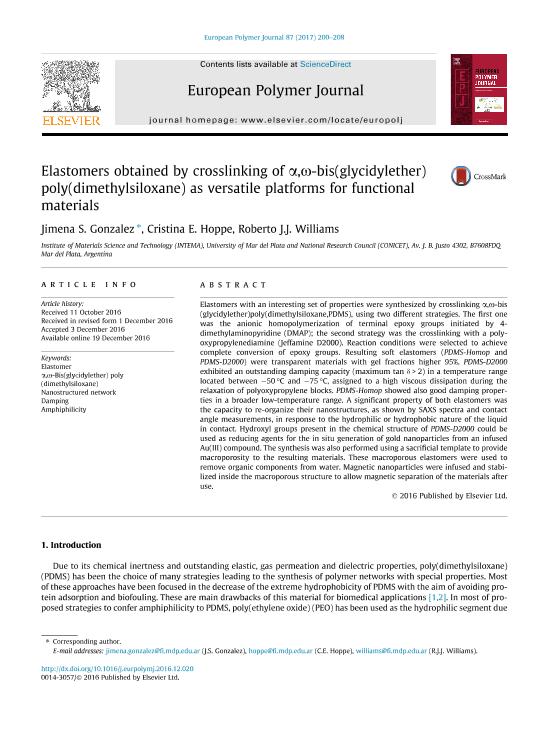Artículo
Elastomers obtained by crosslinking of α,ω-bis(glycidylether) poly(dimethylsiloxane) as versatile platforms for functional materials
Fecha de publicación:
19/12/2016
Editorial:
Elsevier
Revista:
European Polymer Journal
ISSN:
0014-3057
Idioma:
Inglés
Tipo de recurso:
Artículo publicado
Clasificación temática:
Resumen
Elastomers with an interesting set of properties were synthesized by crosslinking α,ω-bis(glycidylether)poly(dimethylsiloxane,PDMS), using two different strategies. The first one was the anionic homopolymerization of terminal epoxy groups initiated by 4-dimethylaminopyridine (DMAP); the second strategy was the crosslinking with a polyoxypropylenediamine (Jeffamine D2000). Reaction conditions were selected to achieve complete conversion of epoxy groups. Resulting soft elastomers (PDMS-Homop and PDMS-D2000) were transparent materials with gel fractions higher 95%. PDMS-D2000 exhibited an outstanding damping capacity (maximum tan δ > 2) in a temperature range located between −50 °C and −75 °C, assigned to a high viscous dissipation during the relaxation of polyoxypropylene blocks. PDMS-Homop showed also good damping properties in a broader low-temperature range. A significant property of both elastomers was the capacity to re-organize their nanostructures, as shown by SAXS spectra and contact angle measurements, in response to the hydrophilic or hydrophobic nature of the liquid in contact. Hydroxyl groups present in the chemical structure of PDMS-D2000 could be used as reducing agents for the in situ generation of gold nanoparticles from an infused Au(III) compound. The synthesis was also performed using a sacrificial template to provide macroporosity to the resulting materials. These macroporous elastomers were used to remove organic components from water. Magnetic nanoparticles were infused and stabilized inside the macroporous structure to allow magnetic separation of the materials after use.
Archivos asociados
Licencia
Identificadores
Colecciones
Articulos(INTEMA)
Articulos de INST.DE INV.EN CIENCIA Y TECNOL.MATERIALES (I)
Articulos de INST.DE INV.EN CIENCIA Y TECNOL.MATERIALES (I)
Citación
Gonzalez, Jimena Soledad; Hoppe, Cristina Elena; Williams, Roberto Juan Jose; Elastomers obtained by crosslinking of α,ω-bis(glycidylether) poly(dimethylsiloxane) as versatile platforms for functional materials; Elsevier; European Polymer Journal; 87; 19-12-2016; 200-208
Compartir
Altmétricas




